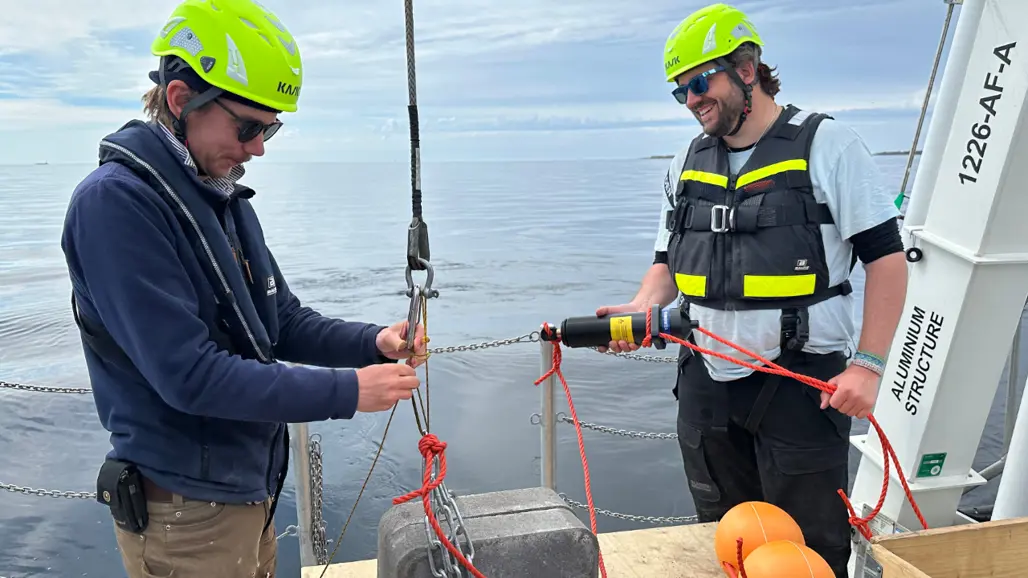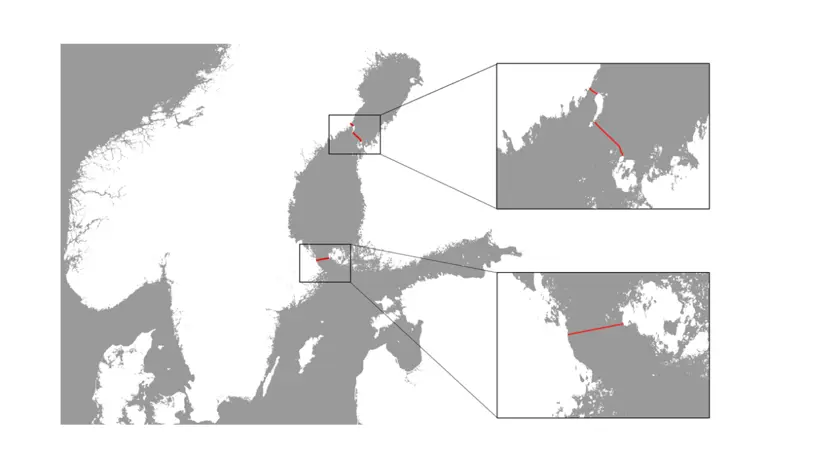
SLU launches large-scale fish tracking – aiming to provide new insights about fish in the Baltic Sea
SLU has deployed 80 acoustic receivers along two lines in the Baltic Sea. By listening for signals from tagged fish, the receivers will reveal migration routes and uncover new insights on life beneath the waves. This is important for both research and management of fish in the Baltic Sea.
The sun peeks through the fog over Northern Kvarken. On board the ship Ocean Seeker, researchers from The Swedish University of Agricultural Sciences (SLU) and the Finnish Natural Resources Institute LUKE are ready to lower the last of a total of 40 acoustic receivers that have been deployed on the seabed in a line between Sweden and Finland. Further south, in a line across the Sea of Åland, there are now also 40 receivers. They register signals from tagged fish swimming by. Researchers at the Department of Wildlife, Fish and Environmental Studies at SLU in Umeå have been looking forward to this day. The receivers represent a major step towards large-scale fish tracking in the Baltic Sea, or the ‘Baltic Sea Tracking Network’ as they themselves call the initiative.
– This is something we have been working towards for many years. Until now, we have mainly used acoustic telemetry to study fish movements within relatively limited areas. But now, for the first time, we can begin to answer bigger questions about fish movement patterns and survival in the Baltic Sea. It feels fantastic, says Gustav Hellström, Senior Lecturer at SLU in Umeå.
More knowledge about salmon in the sea
Acoustic telemetry is the most effective method for collecting accurate data about fish in the wild. It is based on sound signals from fish equipped with transmitters being picked up by receivers. The method is well proven and has been developed since the 1960s. SLU uses the technology in several different projects around the world to track, for example, sturgeon, Greenland shark, tuna, trout and salmon.
In the Baltic Sea, they will now be able to study for example salmon, cod, herring, whitefish and eel. It is primarily salmon that the researchers hope to learn more about. They have long followed the migration of salmon in rivers but have less knowledge of what happens from the time young salmon, smolt, migrate to the sea until they return to the rivers.
– The new infrastructure provides us with detailed data on how quickly the tagged salmon migrate, for example, from the Torne River down to Northern Kvarken and then on to the Sea of Åland. Not all salmon survive their time in the sea, and now we will be able to see where in the Baltic Sea the losses are greatest. This will give us important knowledge that can be used for management measures to improve the situation for salmon, says Johan Leander, Researcher at SLU in Umeå.
Apart from salmon, are there any other tagged fish that you hope will turn up?
– There are sturgeons that have been tagged in Germany and released into the Baltic Sea. It would be a nice surprise if one of these were to be registered in Northern Kvarken, says Johan Leander.
Open platform for researchers
Next year, the first batch of collected data will be processed. The receivers will then be detached from their moorings using remote control and retrieved when they float to the surface. After the information has been downloaded, they will be deployed again. Swedish and Finnish researchers are eagerly awaiting the first results, but other researchers can also benefit from the infrastructure.
The receivers listen to the most common frequency for large-scale fish tracking, 69 kHz, and are ready to read signals from virtually all fish that researchers have equipped with transmitters. The detections are then uploaded on the Ocean Tracking Network (OTN) platform, where researchers collaborate by sharing data on tagged fish.
– Collaboration via the platform is invaluable when we study species that move over large areas. By sharing data on tagged fish and detections from the fish tracking infrastructures along our coasts and seas, we can now answer questions we previously dared not even dream of, and even some questions we probably never even thought of in the first place, says Johan Leander.
He highlights the technology used in the Baltic Sea as crucial.
– The receivers we use are not limited to a particular manufacturer's transmitters. This makes collaboration easier and knowledge exchange greater, says Johan Leander.
The receivers will not affect the general public or marine traffic.

Baltic Sea Tracking Network (BSTN)
BSTN is a comprehensive fish tracking infrastructure aimed at increasing knowledge about how fish move across large areas of the Baltic Sea.
The initiative is led by the Swedish University of Agricultural Sciences (SLU) together with the Natural Resources Institute Finland (LUKE) with support from Voice of the Ocean (VOTO), Ocean Tracking Network (OTN) and the Kempe Foundation.
Funding: Voice of the Ocean, Ocean Tracking Network and the Kempe Foundation.
The project team includes SLU researchers Gustav Hellström, Johan Leander, Petter Lundberg, Daniel Palm and Tomas Brodin.
New partners are warmly welcomed.
Contact
-
PersonJohan Leander, ResearcherDepartment of Wildlife, Fish and Environmental Studies
-
PersonGustav Hellström, Senior LecturerDepartment of Wildlife, Fish and Environmental Studies
-
PersonFrida Wengberg, Communications OfficerDepartment of Wildlife, Fish and Environmental Studies